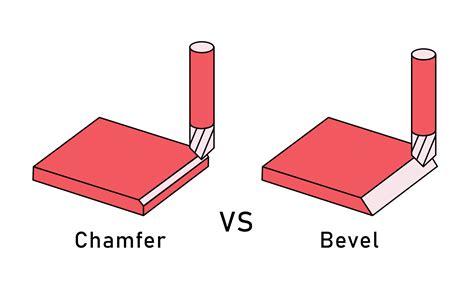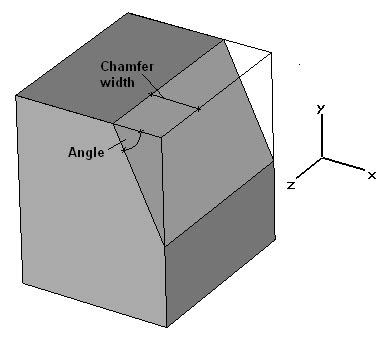chamfer sheet metal Chamfer, a term widely used in both CAD and engineering, refers to the process of creating an angled or beveled edge. In CAD, chamfering edge is a common technique used to smooth and enhance the safety of model edges. Discover unique ways to repurpose metal toolboxes into functional and decorative items. Get inspired and transform your old toolboxes into something new and exciting.
0 · what is a chamfer
1 · sheet metal chamfer angle
2 · how to make a chamfer
3 · chamfered edge on sheet metal
4 · chamfer radius sheet metal
5 · chamfer length and width
6 · chamfer edge chart
7 · chamfer design examples
When foreign visitors—and even Americans—see the five-pointed stars affixed to the walls of numerous rural American homes, they are frequently perplexed. The majority of stars are composed of metal, though some are also .
Chamfers and radii are commonly requested features in custom sheet metal fabrication that can occasionally cause confusion. Whether your sheet metal parts need the .
Corner construction plays a vital role in ensuring the durability and strength of .
Chamfer, a term widely used in both CAD and engineering, refers to the process of creating an angled or beveled edge. In CAD, chamfering edge is a common technique used to smooth and enhance the safety of model edges. A newly machined metal part can end up with edges that are sharper than desired for the end user unless the design smooths or breaks . Have you ever wondered how sharp edges on metal parts are smoothed out? This process, known as chamfering, transforms dangerous, jagged corners into safer, angled surfaces. In this article, you’ll learn the . When chamfering sheet metal, it is recommended to use the Sheet metal corner break feature. Select a measurement type for non-planar adjacent faces. Note that both options behave exactly the same for planar faces.
what is a chamfer
Chamfering is the process of cutting the edges and corners of the metal part to smooth a sharp corner. Chamfers are usually made at a 45-degree angle. Chamfering .
Corner chamfers and radii simplify sheet metal assembly by creating clearance between laser-cut corners and bends on adjoining parts. Essentially, we have adequate space to position parts precisely in place . Corner construction plays a vital role in ensuring the durability and strength of sheet metal parts. When corners are not properly prepared for welding, it can lead to parts being out of tolerance, weak, and susceptible to .
Chamfering best practices. Though chamfering can be done with a hand tool, it would be a primitive choice. Your best bet is to chamfer your edges with a chamfer mill. However, if you’re working on a hole you will be using a . Chamfers and radii are commonly requested features in custom sheet metal fabrication that can occasionally cause confusion. Whether your sheet metal parts need the angled edge of a chamfer or the rounded edge of a radius, there .
sheet metal chamfer angle
Either can eliminate what would be sharp and raw or semi-raw cut metal corners and replace them with either a rounded corner—a radius—or an angled or beveled corner—a chamfer. There are a lot of reasons why you should incorporate chamfers or radii in your sheet metal designs. Here are five big ones.
Chamfer, a term widely used in both CAD and engineering, refers to the process of creating an angled or beveled edge. In CAD, chamfering edge is a common technique used to smooth and enhance the safety of model edges. A newly machined metal part can end up with edges that are sharper than desired for the end user unless the design smooths or breaks those sharp edges. To create an edge break, the design should incorporate sloped or beveled edges and corners known as chamfers—or rounded ones called fillets. Have you ever wondered how sharp edges on metal parts are smoothed out? This process, known as chamfering, transforms dangerous, jagged corners into safer, angled surfaces. In this article, you’ll learn the different types of chamfering, their purposes, and the methods used, ensuring safer and higher-quality mechanical components. I. When chamfering sheet metal, it is recommended to use the Sheet metal corner break feature. Select a measurement type for non-planar adjacent faces. Note that both options behave exactly the same for planar faces.
how to make a chamfer
Chamfering is the process of cutting the edges and corners of the metal part to smooth a sharp corner. Chamfers are usually made at a 45-degree angle. Chamfering removes the burrs on the machined parts due to machining. Corner chamfers and radii simplify sheet metal assembly by creating clearance between laser-cut corners and bends on adjoining parts. Essentially, we have adequate space to position parts precisely in place before fastening or welding them.
Corner construction plays a vital role in ensuring the durability and strength of sheet metal parts. When corners are not properly prepared for welding, it can lead to parts being out of tolerance, weak, and susceptible to breakage. Chamfering best practices. Though chamfering can be done with a hand tool, it would be a primitive choice. Your best bet is to chamfer your edges with a chamfer mill. However, if you’re working on a hole you will be using a drill or spot drill typically with a solid stainless steel or carbide body.
Chamfers and radii are commonly requested features in custom sheet metal fabrication that can occasionally cause confusion. Whether your sheet metal parts need the angled edge of a chamfer or the rounded edge of a radius, there .
Either can eliminate what would be sharp and raw or semi-raw cut metal corners and replace them with either a rounded corner—a radius—or an angled or beveled corner—a chamfer. There are a lot of reasons why you should incorporate chamfers or radii in your sheet metal designs. Here are five big ones.Chamfer, a term widely used in both CAD and engineering, refers to the process of creating an angled or beveled edge. In CAD, chamfering edge is a common technique used to smooth and enhance the safety of model edges. A newly machined metal part can end up with edges that are sharper than desired for the end user unless the design smooths or breaks those sharp edges. To create an edge break, the design should incorporate sloped or beveled edges and corners known as chamfers—or rounded ones called fillets. Have you ever wondered how sharp edges on metal parts are smoothed out? This process, known as chamfering, transforms dangerous, jagged corners into safer, angled surfaces. In this article, you’ll learn the different types of chamfering, their purposes, and the methods used, ensuring safer and higher-quality mechanical components. I.

When chamfering sheet metal, it is recommended to use the Sheet metal corner break feature. Select a measurement type for non-planar adjacent faces. Note that both options behave exactly the same for planar faces. Chamfering is the process of cutting the edges and corners of the metal part to smooth a sharp corner. Chamfers are usually made at a 45-degree angle. Chamfering removes the burrs on the machined parts due to machining. Corner chamfers and radii simplify sheet metal assembly by creating clearance between laser-cut corners and bends on adjoining parts. Essentially, we have adequate space to position parts precisely in place before fastening or welding them. Corner construction plays a vital role in ensuring the durability and strength of sheet metal parts. When corners are not properly prepared for welding, it can lead to parts being out of tolerance, weak, and susceptible to breakage.
chamfered edge on sheet metal

chamfer radius sheet metal
chamfer length and width
Metallic, Rubber, or Plastic Smells. Meanwhile, rubber or metallic smells emanating from your heating system are often caused by overheating components or malfunctioning parts including the belt, blower motor, or other mechanical components, often due to wear and tear or aging.
chamfer sheet metal|chamfer length and width